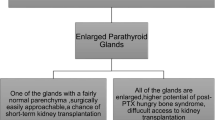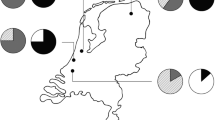Abstract.
There are scant data on the frequency of parathyroidectomy (PTX) for end-stage renal disease (ESRD). Medical therapy for ESRD and secondary hyperparathyroidism has evolved to include better dialytic urea removal and the use of calcitriol. The aim of this study was to determine whether medical therapy has changed the frequency or indications for PTX in the management of renal failure. Hospital and clinic records were analyzed to gather information on all patients undergoing PTX for secondary hyperparathyroidism (2HPT) (n= 48) and tertiary hyperparathyroidism (3HPT) (n= 26) from 1986 through 1998 at our institution. Prospective computer databases were queried for information concerning both chronic dialysis and renal transplant patients at our center. The patients were divided based on date of operation before or after 1991, a divider that separated the patients into groups before or after the widespread adoption of intravenous calcitriol treatment during hemodialysis at our institution. Over the 12 year period, the proportion of our chronic dialysis patients undergoing PTX did not change significantly, ranging from 0% to 2.5% per year. Comparing all patients undergoing PTX for 2HPT during 1986–1991 versus 1992–1998, there was no significant difference in time on dialysis [7.0 ± 4.2 (n= 11) vs. 7.5 ± 4.6 (n= 36) years, mean ± SD]. The later group had higher intact parathyroid hormone (iPTH) levels [765 ± 415 (n= 6) vs. 1377 ± 636 (n= 28) pg/ml; p= 0.03], lower serum calcium [11.2 ± 1.0 (n= 12) vs. 9.9 ± 1.5 (n= 34) mg/dl; p= 0.006], and higher serum phosphate [5.7 ± 1.6 (n= 12) vs. 7.2 ± 2.3 (n= 31) mg/dl; p= 0.042]. Among the population of patients with transplants undergoing PTX for 3HPT, the average percent per year undergoing PTX ranged from 0% to 4.2% and did not change during the study period. Comparing the 1986–1991 group to the 1992–1998 group, the time from transplantation to PTX did not change during the study period (3.3 ± 2.3 vs. 2.9 ± 3.0 years; p= 0.391), and there were no significant differences between preoperative calcium levels or iPTH levels. Despite advances in dialysis technique and pharmacologic therapy, there has been no change in the proportion of dialysis patients requiring PTX for 2HPT or 3HPT. There was also no change in the time on dialysis for patients with 2HPT or the time from transplant to PTX for patients with 3HPT. Analysis of preoperative biochemical markers as evidence of disease severity suggests there was no change in indications for PTX during our study. From this information we conclude that parathyroid pathophysiology is incompletely understood and medical therapy is not optimal, resulting in a continuing need for PTX in some patients.
Similar content being viewed by others
Author information
Authors and Affiliations
Rights and permissions
About this article
Cite this article
Decker, P., Cohen, E., DoffekB.S., K. et al. Subtotal Parathyroidectomy in Renal Failure: Still Needed after All These Years. World J. Surg. 25, 708–712 (2001). https://doi.org/10.1007/s00268-001-0019-2
Published:
Issue Date:
DOI: https://doi.org/10.1007/s00268-001-0019-2




